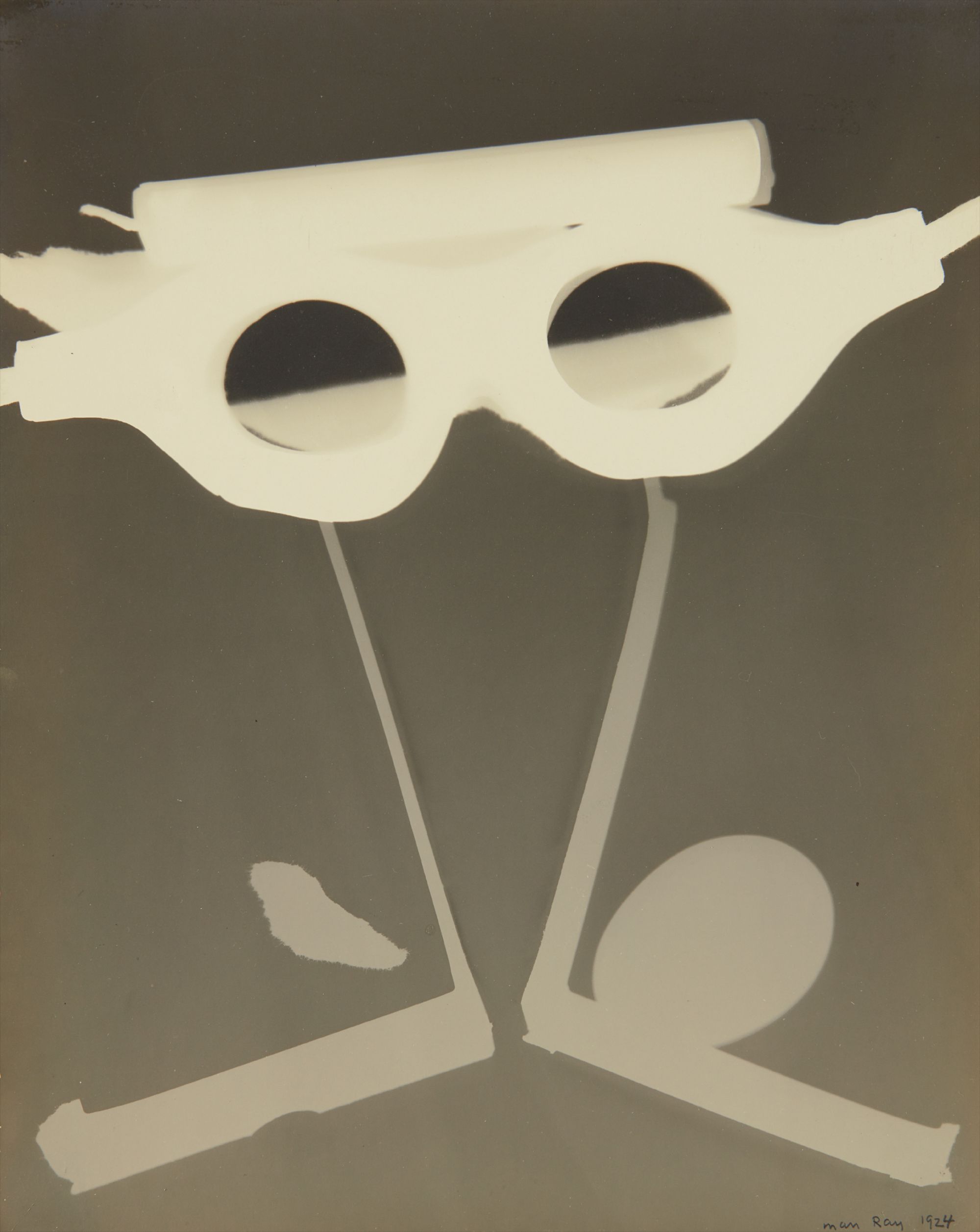

245
Man Ray
Rayograph with Goggles, Egg and Candle
1924
Unique gelatin silver print.
11 5/8 x 9 3/8 in. (29.5 x 23.8 cm)
Signed and dated in pencil on the recto; 'Rue Campagne Premiére, Paris XIVe' (M6) credit stamp on the verso.
Full-Cataloguing
This seminal rayograph was exhibited in London’s 1936 International Surrealist Exhibition, the first major exhibition of Surrealist art in England. Originally in the collection of an editor at the French publishing house Brunidor, it was likely created on the same day as another important rayograph that was illustrated in James Thrall Soby’s publication Man Ray Photographs 1920 - 1934 Paris (1934), and later donated by Soby to The Museum of Modern Art, New York. Both rayographs, created using the same two key elements, were founded on the principles of the Dada movement, but have long been seen, exhibited and published as important examples of Surrealism.
By the early 1920s most of the founders of Dada had arrived in Paris: Man Ray, Francis Picabia and Marcel Duchamp came from New York, Hans Arp and Tristan Tzara from Zurich. The Dada poet Tzara brought with him a group of small photograms or "schadographs" made by the German artist Christian Schad, and it is likely that Tzara shared these printing-out photograms with Man Ray, as they both lived in the same hotel. Man Ray’s discovery of the photogram or “rayograph” also occurred shortly after his arrival in Paris. His unique cameraless pictures were acclaimed by the Dadaists for their inherent pre-consciousness, their “readymade” use of discursive repurposing, and the photogram’s implicit rejection of traditional painting in favor of chemistry and technology.
In 1922 a portfolio of Man Ray’s rayographs, Les champs délicieux (The Delightful Fields) was published with an introduction by Tzara. Just two years later, in 1924, the rayograph on offer was created amidst fluidity within the Parisian art scene, as in the same year, André Breton’s first Surrealist Manifesto marked the end of Dada. Soon thereafter, the Surrealists embraced Man Ray and his radical rayographs in a new way, and by the mid-1920s these shape-shifting images were seen as early Surrealist repositories of the unconscious.
Susan Laxton in her essay Painting with Light, points out that Man Ray’s rayographs were serial. In any given day he would expose a set of objects on a sheet of developing-out paper, remove them and slip the blank sheet of paper into the developing tray, then repeat with varying permutations of the same group of objects. Based on the research of Steven Manford, the lot on offer is likely from a group of six rayographs made that day. In both this rayograph and the one in MoMA’s collection, donated by Soby, Man Ray used a pair of motorist goggles and a candle. The print in MoMA’s collection also has a gray toned doily, and the shadowy presence of hands, while in this rayograph there is an egg floating in the gray tonal realm, which is embryonically attached by two mechanically cut forms.
This radical Dada/Surrealist image waivers between abstraction and description, photographic reality and psycho-perceptual existence, and though existing on a two-dimensional piece of paper, boldly takes on the appearance of sculptural materiality.
Man Ray Research Scholar Steven Manford is the author of the forthcoming catalogue raisonne of the Rayographs, which will include the Rayograph on offer here.
By the early 1920s most of the founders of Dada had arrived in Paris: Man Ray, Francis Picabia and Marcel Duchamp came from New York, Hans Arp and Tristan Tzara from Zurich. The Dada poet Tzara brought with him a group of small photograms or "schadographs" made by the German artist Christian Schad, and it is likely that Tzara shared these printing-out photograms with Man Ray, as they both lived in the same hotel. Man Ray’s discovery of the photogram or “rayograph” also occurred shortly after his arrival in Paris. His unique cameraless pictures were acclaimed by the Dadaists for their inherent pre-consciousness, their “readymade” use of discursive repurposing, and the photogram’s implicit rejection of traditional painting in favor of chemistry and technology.
In 1922 a portfolio of Man Ray’s rayographs, Les champs délicieux (The Delightful Fields) was published with an introduction by Tzara. Just two years later, in 1924, the rayograph on offer was created amidst fluidity within the Parisian art scene, as in the same year, André Breton’s first Surrealist Manifesto marked the end of Dada. Soon thereafter, the Surrealists embraced Man Ray and his radical rayographs in a new way, and by the mid-1920s these shape-shifting images were seen as early Surrealist repositories of the unconscious.
Susan Laxton in her essay Painting with Light, points out that Man Ray’s rayographs were serial. In any given day he would expose a set of objects on a sheet of developing-out paper, remove them and slip the blank sheet of paper into the developing tray, then repeat with varying permutations of the same group of objects. Based on the research of Steven Manford, the lot on offer is likely from a group of six rayographs made that day. In both this rayograph and the one in MoMA’s collection, donated by Soby, Man Ray used a pair of motorist goggles and a candle. The print in MoMA’s collection also has a gray toned doily, and the shadowy presence of hands, while in this rayograph there is an egg floating in the gray tonal realm, which is embryonically attached by two mechanically cut forms.
This radical Dada/Surrealist image waivers between abstraction and description, photographic reality and psycho-perceptual existence, and though existing on a two-dimensional piece of paper, boldly takes on the appearance of sculptural materiality.
Man Ray Research Scholar Steven Manford is the author of the forthcoming catalogue raisonne of the Rayographs, which will include the Rayograph on offer here.